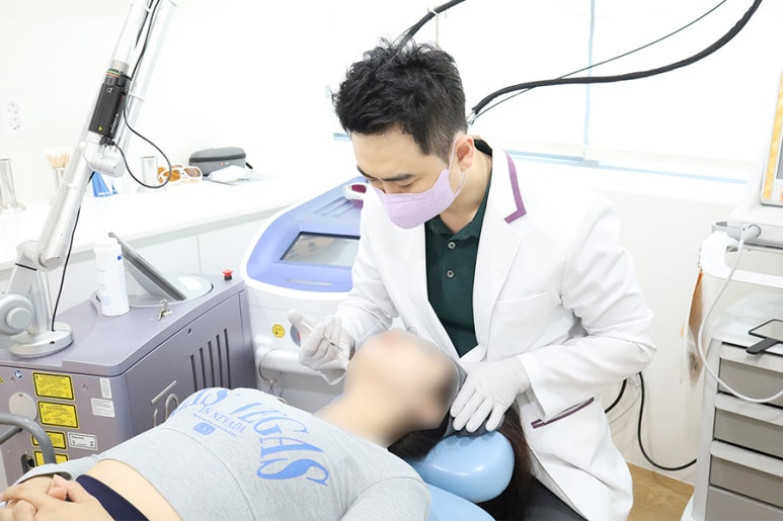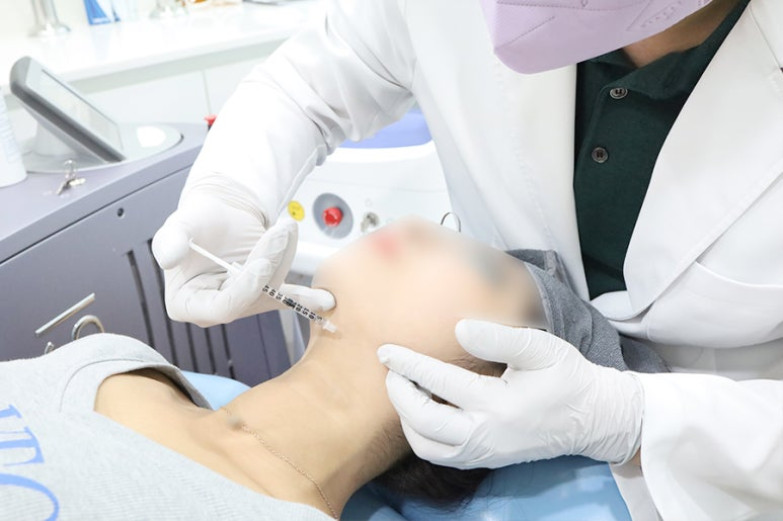Botox: Principles, Effects, and Differences Between Jaw and Salivary Gland Botox

This post is directly written by Purple Clinic and provides medical information only.
This posting does not require prior review as it solely delivers medical information.
This article is for informational purposes only and does not promote specific drugs or medical devices.
It complies with Article 56, Paragraph 1 of the Medical Law (Prohibition of Medical Advertising, etc.).
The Principles and Aesthetic Effects of Botox
Botox is not actually a product name, but a trademarked name for the ingredient Botulinum Toxin.
This ingredient temporarily blocks the release of acetylcholine, which transmits signals between nerves and muscles, thereby reducing muscle contraction.
In simple terms, it relaxes overly active muscles, reducing the appearance of wrinkles.
Areas of Application:
Forehead, Glabella, Crow's Feet: Reduces expression wrinkles
Square Jaw: Reduces excessive development of jaw muscles for a smoother jawline
Salivary Glands: Reduces volume and improves contour
Trapezius Muscles, Calves, Hyperhidrosis: Muscle reduction or sweat control
The effects are not immediate; they gradually appear after 3-7 days and last for about 3-6 months.
Differences Between Jaw Botox and Salivary Gland Botox
Many people say, "I got jaw Botox, but my face is still the same."
This is because the approach differs depending on whether the square jaw is due to muscle or salivary glands.
Jaw Botox is administered to the chewing muscle called the 'masseter muscle'.
It is effective for cases where the muscle has grown due to frequently eating hard foods or clenching the teeth.
Reducing the size of the muscle makes the face look softer and slimmer.
On the other hand, Jamsil Salivary Gland Botox is administered to the 'parotid gland' located under the ear or the 'submandibular gland' under the jaw.
If the salivary glands enlarge, the jawline may look bulging when smiling, and the lower face may feel heavy.
Injecting Botox reduces the volume of the salivary glands, resulting in a more defined facial contour.
In summary, jaw Botox acts on the muscle (masseter muscle), while salivary gland Botox acts on the gland tissue (parotid/submandibular gland).
The Principles and Effects of Salivary Gland Botox
Salivary glands secrete saliva through acetylcholine signals released from nerves.
Botox blocks these signals, reducing excessive secretion and volume of the salivary glands.
This process naturally reduces the volume of the parotid and submandibular glands, resulting in a lighter lower facial contour.
Changes can usually be felt within 2-3 weeks and last for 3-6 months.
In particular, for complex faces with both masseter muscle hypertrophy and salivary gland hypertrophy, both areas should be treated together for a natural improvement in the contour.
However, because the salivary glands are located near nerves and blood vessels, Jamsil Salivary Gland Botox should be injected by a skilled medical professional who can accurately determine the depth and location for increased safety.
When Salivary Gland Botox is Needed
You may consider Jamsil Salivary Gland Botox in the following cases:
The area under the ear remains bulging even after consistent jaw Botox treatments.
The area below the jawline protrudes roundly when smiling.
A soft lump is felt when pressed, and it does not move when chewing.
Complex contour with both masseter muscle hypertrophy and salivary gland hypertrophy.
However, not all 'volume' is due to salivary glands.
It is important to accurately distinguish between muscle type and salivary gland type through a medical examination to ensure proper treatment.
Causes and Management of Botox Resistance
Botox can develop 'resistance' with long-term, repeated use.
This is a phenomenon where the effect gradually weakens as antibodies against Botulinum Toxin are formed in the body.
Resistance is more likely to occur in the following cases:
Repeated treatments at too short intervals
Using more than the necessary amount
Having an immune response to complex proteins
To reduce resistance:
- Maintain treatment intervals of 3 months or more.
- It is important to inject only the necessary minimum dose accurately.
- Also, consider using a pure toxin formulation that has removed complex proteins (e.g., Xeomin, Coretox, etc.).
If you feel the effect has decreased, it is better to consult with a doctor to evaluate whether the cause is resistance or a problem with the depth or dosage of the procedure, rather than immediately getting a repeat Jamsil Salivary Gland Botox treatment.
Why the Skill and Technique of the Practitioner are Important
Botox may seem like a simple 'injection procedure,' but it actually requires anatomical knowledge and a delicate sense of design.
The injection location varies depending on the thickness of the muscle, the direction of movement, and the degree of functional hypertrophy.
In the case of salivary gland Botox, it is important to avoid nerves and blood vessels and inject accurately into the inner layer of the salivary gland.
Symmetry, facial expressions, and chewing habits should be considered after the procedure for natural correction.
In the end, the results can vary greatly depending on who performs the same Jamsil Salivary Gland Botox procedure and how it is performed.
Also, meticulous procedures that take enough time to adjust the accurate depth, angle, and dosage are much more important than quickly treating multiple areas in a short time.
All procedures may vary depending on the individual,
and side effects such as swelling, inflammation, and bleeding may occur, so caution should be exercised.
Purple Clinic
02-421-0613







Source :https://blog.naver.com/purpleclinic/224065694731
No comments yet.
